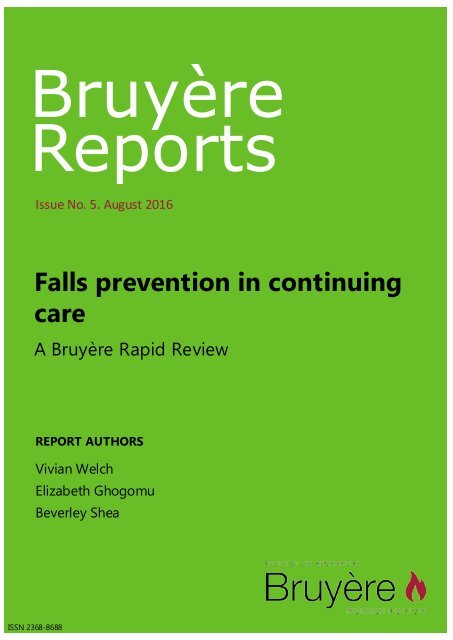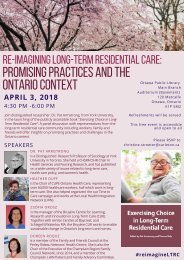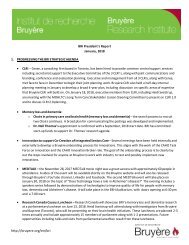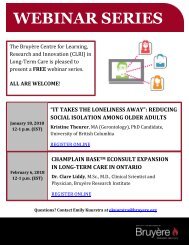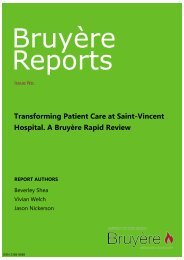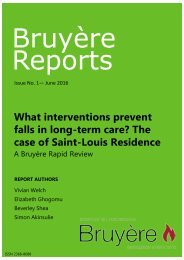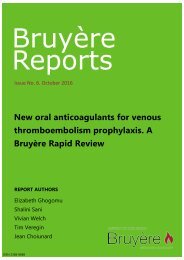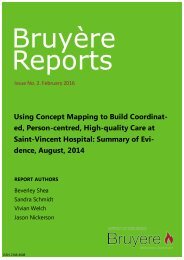Falls Prevention in Continuing Care
Create successful ePaper yourself
Turn your PDF publications into a flip-book with our unique Google optimized e-Paper software.
Bruyère<br />
Reports<br />
Issue No. 5. August 2016<br />
<strong>Falls</strong> prevention <strong>in</strong> cont<strong>in</strong>u<strong>in</strong>g<br />
care<br />
A Bruyère Rapid Review<br />
REPORT AUTHORS<br />
Vivian Welch<br />
Elizabeth Ghogomu<br />
Beverley Shea<br />
ISSN 2368-8688
2
Contents<br />
Key messages 3<br />
Executive summary 4<br />
Background: context and risk factors for falls 5<br />
Evidence review 6<br />
Synthesis of f<strong>in</strong>d<strong>in</strong>gs 7<br />
Gap analysis at SLR <strong>in</strong> 2011 by RNAO prevention coord<strong>in</strong>ator 8<br />
Discussion of evidence review: strengths and limitations 8<br />
Inferences and next steps for SLR 9<br />
References 10<br />
Key messages<br />
<strong>Falls</strong> prevention has been identified as a high priority at Bruyère Cont<strong>in</strong>u<strong>in</strong>g <strong>Care</strong>. Many falls occur as a<br />
result of <strong>in</strong>teractions of multiple risk factors at the <strong>in</strong>dividual and sett<strong>in</strong>g level.<br />
Based on our assessment of the evidence, we recommend three strategies to reduce fall rates <strong>in</strong> Bruyère<br />
Cont<strong>in</strong>u<strong>in</strong>g <strong>Care</strong> sett<strong>in</strong>gs:<br />
Implement a comprehensive risk assessment tool, tailored for the cl<strong>in</strong>ical sett<strong>in</strong>g, for use at admission<br />
to design <strong>in</strong>dividualized, multifactorial falls prevention plans<br />
Implement post-fall huddles to foster ongo<strong>in</strong>g team learn<strong>in</strong>g and cont<strong>in</strong>uously improve the comprehensive<br />
risk assessment process.<br />
Engage staff and clients <strong>in</strong> implement<strong>in</strong>g falls prevention, foster<strong>in</strong>g a culture of ongo<strong>in</strong>g learn<strong>in</strong>g and<br />
cont<strong>in</strong>uous monitor<strong>in</strong>g and improvement of <strong>in</strong>dividual falls prevention plans.<br />
Tools for implement<strong>in</strong>g falls prevention strategies and a review of risk assessment tools is covered <strong>in</strong> the<br />
companion Bruyère Evidence Review.<br />
3
Executive summary<br />
<strong>Falls</strong> prevention has been identified as a high priority<br />
at Bruyère Cont<strong>in</strong>u<strong>in</strong>g <strong>Care</strong>. Many falls occur as a result<br />
of <strong>in</strong>teractions of multiple risk factors at the <strong>in</strong>dividual<br />
and sett<strong>in</strong>g level.<br />
The objective of this review was to assess the effectiveness<br />
of falls prevention <strong>in</strong>terventions <strong>in</strong> four sett<strong>in</strong>gs <strong>in</strong><br />
cont<strong>in</strong>u<strong>in</strong>g care:<br />
1) subacute care;<br />
2) palliative care;<br />
3) rehabilitation and geriatric day unit sett<strong>in</strong>gs; and<br />
4) long term care.<br />
We identified 5 systematic reviews and 4 cl<strong>in</strong>ical practice<br />
guidel<strong>in</strong>es which assessed effectiveness of falls<br />
prevention <strong>in</strong> one or more of these sett<strong>in</strong>gs. The full<br />
report outl<strong>in</strong>es f<strong>in</strong>d<strong>in</strong>gs <strong>in</strong> each of these sett<strong>in</strong>gs and<br />
the quality of the evidence.<br />
Based on our assessment of the evidence, we recommend<br />
three strategies to reduce fall rates <strong>in</strong> Bruyère<br />
Cont<strong>in</strong>u<strong>in</strong>g <strong>Care</strong> sett<strong>in</strong>gs:<br />
<br />
<br />
<br />
Implement a comprehensive risk assessment tool,<br />
tailored for the cl<strong>in</strong>ical sett<strong>in</strong>g, for use at admission<br />
to design <strong>in</strong>dividualized, multifactorial falls<br />
prevention plans<br />
Implement post-fall huddles to foster ongo<strong>in</strong>g<br />
team learn<strong>in</strong>g and cont<strong>in</strong>uously improve the comprehensive<br />
risk assessment process.<br />
Engage staff and clients <strong>in</strong> implement<strong>in</strong>g falls prevention,<br />
foster<strong>in</strong>g a culture of ongo<strong>in</strong>g learn<strong>in</strong>g<br />
and cont<strong>in</strong>uous monitor<strong>in</strong>g and improvement of<br />
<strong>in</strong>dividual falls prevention plans.<br />
Tools for implement<strong>in</strong>g falls prevention strategies and<br />
a review of risk assessment tools is covered <strong>in</strong> the<br />
4
Background: context and risk factors<br />
Context<br />
The Senior Quality Committee of Bruyère Cont<strong>in</strong>u<strong>in</strong>g<br />
<strong>Care</strong> requested a review of evidence regard<strong>in</strong>g falls<br />
prevention <strong>in</strong> the Bruyère cont<strong>in</strong>u<strong>in</strong>g care sett<strong>in</strong>gs:<br />
1) rehabilitation (stroke and geriatric care);<br />
2) palliative care;<br />
3) subacute care; and<br />
4) long term care.<br />
Prevent<strong>in</strong>g falls was identified by a recent Accreditation<br />
Canada report as a high priority(1).<br />
This review of falls prevention <strong>in</strong>terventions will consider<br />
the context of each of these different sett<strong>in</strong>gs<br />
with a focus on feasibility and relevance to the sett<strong>in</strong>g.<br />
Different risk factors are more prevalent <strong>in</strong> different<br />
sett<strong>in</strong>gs. For example, a study at Bruyere Cont<strong>in</strong>u<strong>in</strong>g<br />
<strong>Care</strong> has shown that the risk factors for falls <strong>in</strong> adults<br />
with advanced cancer <strong>in</strong> the palliative care sett<strong>in</strong>g are<br />
different from other sett<strong>in</strong>gs, and <strong>in</strong>clude a primary<br />
bra<strong>in</strong> tumour, a fall <strong>in</strong> the previous 3 months, severity<br />
of depression, benzodiazep<strong>in</strong>e use(2). These differences<br />
may require a tailored approach to falls prevention.<br />
<strong>Falls</strong> are a major public health problem and the lead<strong>in</strong>g<br />
cause of <strong>in</strong>jury-related hospitalizations among<br />
seniors (aged 65 and older) <strong>in</strong> Canada; 20 to 30% will<br />
experience a fall each year(3) and 85% of all fallrelated<br />
hospitalizations are due to falls <strong>in</strong> seniors(1).<br />
Half of people aged 85 and older will fall each year<br />
and 12% to 42% who fall will have a fall-related <strong>in</strong>jury<br />
(4). There are more fall-related hospitalizations associated<br />
with serious <strong>in</strong>juries such as hip fractures <strong>in</strong> seniors<br />
liv<strong>in</strong>g <strong>in</strong> long-term residential care (59%) than <strong>in</strong><br />
the community (32%)(3). The direct health care costs<br />
for fall-related <strong>in</strong>juries <strong>in</strong> Canada are estimated at $2<br />
billion annually(1, 3).<br />
Risk factors for falls<br />
Fall<strong>in</strong>g is associated with a variety of risk factors <strong>in</strong>clud<strong>in</strong>g<br />
biological, behavioural, environmental and<br />
socioeconomic risk factors(3). Many falls occur as a<br />
result of <strong>in</strong>teractions of multiple risk factors(3). The<br />
most powerful predictor of a fall is a history of fall<strong>in</strong>g<br />
(1). <strong>Falls</strong> can occur <strong>in</strong> the home or <strong>in</strong> various hospital<br />
sett<strong>in</strong>gs <strong>in</strong>clud<strong>in</strong>g cont<strong>in</strong>u<strong>in</strong>g care and acute care.<br />
Cont<strong>in</strong>u<strong>in</strong>g care <strong>in</strong>volves two types of care – residential-based<br />
care and hospital-based care(1). Risk factors<br />
and associated odds of fall<strong>in</strong>g for communitydwell<strong>in</strong>g,<br />
hospitalized and residential or nurs<strong>in</strong>g home<br />
Evidence review<br />
We searched for relevant systematic reviews and<br />
guidel<strong>in</strong>es published between January 2007 and June<br />
2015 <strong>in</strong> Medl<strong>in</strong>e, the Cochrane Library (DARE and<br />
HTA) and Trip Database (Appendix 1). The search results<br />
and potentially eligible articles were screened<br />
and reviewed <strong>in</strong> duplicate. The quality of eligible<br />
guidel<strong>in</strong>es and systematic reviews was assessed us<strong>in</strong>g<br />
the AGREE score and AMSTAR checklist respectively<br />
(Appendix 2).<br />
Evidence review: Risk factors for falls<br />
Based on a 2013 updated assessment of risk by the<br />
American College of Physicians, the most important<br />
predictors of risk of fall<strong>in</strong>g <strong>in</strong> hospitalized patients<br />
were a history of a previous fall (3 times higher risk),<br />
ambulatory aids (3 times higher risk), vision impairment<br />
(2 times higher risk), cognitive impairment (3-6<br />
times higher risk) and the presence of poly-pharmacy<br />
or benzodiazep<strong>in</strong>es (2-7 times higher risk). Other risk<br />
factors for falls <strong>in</strong> hospitalized patients are shown <strong>in</strong><br />
Table 1.<br />
Some risk factors may be more common <strong>in</strong> some sett<strong>in</strong>gs<br />
e.g. ambulatory aids <strong>in</strong> rehabilitation care(6);<br />
cognitive impairment <strong>in</strong> palliative care(7). For subacute<br />
care, balance and cerebrovascular disorders are<br />
more common <strong>in</strong> the stroke unit(8); polypharmacy<br />
and psychotropic drug use are more common <strong>in</strong> geriatric<br />
care(9). History of previous fall is the best predictor<br />
of subsequent falls <strong>in</strong> long-term care (LTC)(10, 11).<br />
5
Evidence review<br />
Evidence review: Systematic reviews of<br />
falls prevention<br />
We identified 5 systematic reviews of falls prevention<br />
(12-16). Two reviews were focused on subacute care<br />
(geriatric care, rehabilitation)(12, 13); one review on<br />
stroke patients <strong>in</strong> rehabilitation care(16); and two <strong>in</strong>cluded<br />
diverse hospital sett<strong>in</strong>gs (14, 15). We summarize<br />
the evidence on effectiveness below <strong>in</strong> a s<strong>in</strong>gle<br />
table, with a description about sett<strong>in</strong>g-specific f<strong>in</strong>d<strong>in</strong>gs<br />
below. Their quality varied from 2-11/11 on the<br />
AMSTAR score.<br />
SUBACUTE CARE SETTINGS<br />
In subacute sett<strong>in</strong>gs, two reviews concluded that unifactorial<br />
falls prevention <strong>in</strong>terventions were <strong>in</strong>effective<br />
(i.e. bracelets to identify those at high risk, low-low<br />
beds, staff education, carpet vs v<strong>in</strong>yl floor), possibly<br />
due to short stays with <strong>in</strong>adequate time to reap the<br />
benefits of <strong>in</strong>terventions(13, 15). However, risk assessment<br />
followed by targeted multifactorial <strong>in</strong>terventions<br />
<strong>in</strong>clud<strong>in</strong>g exercise, medication review, environmental<br />
review, vision correction, education were effective<br />
based on high quality evidence from randomized trials.<br />
REHABILITATION SETTING<br />
Similar to subacute sett<strong>in</strong>gs, unifactorial falls prevention<br />
<strong>in</strong>terventions have not shown evidence of benefit<br />
<strong>in</strong> high quality studies. However, risk assessment followed<br />
by targeted <strong>in</strong>terventions to address identified<br />
risks was effective at prevent<strong>in</strong>g falls. Also, vitam<strong>in</strong> D<br />
was effective for those who were vitam<strong>in</strong> D deficient,<br />
and had duration of stay of >12 weeks.<br />
PALLIATIVE CARE SETTING<br />
We found one systematic review of risk factors for <strong>in</strong>patient<br />
oncology patients fall<strong>in</strong>g (ma<strong>in</strong>ly <strong>in</strong> palliative care<br />
sett<strong>in</strong>gs)(17). This review <strong>in</strong>cluded six studies of the <strong>in</strong>patient<br />
sett<strong>in</strong>g, <strong>in</strong>clud<strong>in</strong>g a prospective study conducted <strong>in</strong><br />
Bruyère Cont<strong>in</strong>u<strong>in</strong>g <strong>Care</strong>(2). Almost half of patients admitted<br />
to palliative care experience a fall, and the follow<strong>in</strong>g<br />
risk factors were identified: previous fall (odds ratio<br />
9.5), cognitive impairment (odds ratio 10.5), delirium<br />
(odds ratio 2.2), depression (odds ratio 2.8), bra<strong>in</strong> metastases<br />
(odds ratio 7.5), physical performance measures (e.g.<br />
gait) (odds ratio 11.6), gender (women were more likely to<br />
fall than men), age. The number of medications taken was<br />
not associated with fall<strong>in</strong>g, but use certa<strong>in</strong> medications<br />
was associated with <strong>in</strong>creased risk of fall<strong>in</strong>g <strong>in</strong>clud<strong>in</strong>g antipsychotics,<br />
odds ratio 4.9; corticosteroids, odds ratio 2.8;<br />
and benzodiazep<strong>in</strong>es (odds ratio 2.15).<br />
We did not f<strong>in</strong>d evidence on falls prevention <strong>in</strong>terventions<br />
<strong>in</strong> palliative care sett<strong>in</strong>gs.<br />
LONG TERM CARE SETTING<br />
Interventions which were shown to prevent five or<br />
more falls per 100 people per year were:<br />
Client education<br />
Strength and balance tra<strong>in</strong><strong>in</strong>g<br />
Medication review and discont<strong>in</strong>uation, where<br />
appropriate<br />
Multifactorial <strong>in</strong>terventions<br />
Wireless position monitor<strong>in</strong>g<br />
Vitam<strong>in</strong> D supplementation<br />
Staff education on patient safety<br />
6
Summary Table: Synthesis of falls prevention <strong>in</strong>tervention <strong>in</strong> hospital sett<strong>in</strong>gs<br />
Interventions Long term care Stroke & rehabilitation<br />
#falls/100 people/year<br />
Subacute<br />
Palliative<br />
Strength and balance tra<strong>in</strong><strong>in</strong>g, 11 falls ↔No effect 8 falls<br />
Vitam<strong>in</strong> D supplementation for those 7 falls if stay >12 ↔No effect<br />
who are vitam<strong>in</strong> D deficient,<br />
weeks<br />
Multifactorial <strong>in</strong>terventions 8 falls 6 falls<br />
Client education,<br />
14 falls<br />
Medication review /pharmacist outreach,<br />
8 falls<br />
Fluid for dehydration and management<br />
of ur<strong>in</strong>ary <strong>in</strong>cont<strong>in</strong>ence<br />
8 falls<br />
No data<br />
Staff education on patient safety 7 falls ↔No effect<br />
Fall risk assessment at admission and<br />
post fall + targeted multifactorial <strong>in</strong>tervention<br />
1<br />
Wireless position monitor<strong>in</strong>g vs usual<br />
care for those at high risk<br />
risk assessment<br />
alone<br />
<strong>in</strong>effective<br />
7 falls<br />
11 falls<br />
11 falls<br />
? conflict<strong>in</strong>g<br />
evidence of<br />
benefit<br />
↔No effect<br />
Pressure-sensitive mats or bed/chair ↔No effect<br />
alarms<br />
Bracelets to identify high risk patients No data ↔No effect ↔No effect<br />
Carpet vs v<strong>in</strong>yl floor<strong>in</strong>g, No data<br />
<strong>in</strong>creases<br />
falls<br />
Low-low beds, ? ↔No effect<br />
Exercise programs<br />
<strong>in</strong>creased<br />
risk of falls 2<br />
<strong>in</strong>creased<br />
risk of falls 3<br />
<strong>in</strong>creased<br />
risk of falls 4<br />
1<br />
targeted multifactorial <strong>in</strong>tervention <strong>in</strong>cludes falls risk assessment, exercise, medication review, vision correction, education,<br />
environmental review, medical exam<strong>in</strong>ation (Healey)<br />
2 Exercise program <strong>in</strong>volved brisk walk<strong>in</strong>g<br />
3 Exercise program <strong>in</strong>volved post-stroke patients walk<strong>in</strong>g on a treadmill<br />
4<br />
Exercise program <strong>in</strong>volved seated leg strengthen<strong>in</strong>g exercises<br />
favourable effect; ↔No effect; ? conflict<strong>in</strong>g evidence; unfavourable effect<br />
7
Cl<strong>in</strong>ical practice guidel<strong>in</strong>es for falls prevention<br />
We identified four guidel<strong>in</strong>es for falls prevention <strong>in</strong><br />
hospital-based cont<strong>in</strong>u<strong>in</strong>g care sett<strong>in</strong>g(11, 18-20). We<br />
excluded guidel<strong>in</strong>es on acute care sett<strong>in</strong>gs only because<br />
we expect differences <strong>in</strong> the patients and sett<strong>in</strong>gs<br />
may lead to different drivers of falls than the cont<strong>in</strong>u<strong>in</strong>g<br />
care sett<strong>in</strong>gs<br />
Recommended <strong>in</strong>terventions <strong>in</strong> guidel<strong>in</strong>es were <strong>in</strong><br />
agreement with f<strong>in</strong>d<strong>in</strong>gs <strong>in</strong> the systematic reviews.<br />
Comprehensive falls risk on admission (Silver )<br />
[see below for components]<br />
Tailored, multifactorial <strong>in</strong>terventions (based on<br />
<br />
comprehensive risk assessment) (Silver )<br />
Exercise as part of multifactorial program (Silver<br />
)<br />
Client engagement and education (Bronze )<br />
Staff education and engagement (Bronze )<br />
Post-fall assessment and problem solv<strong>in</strong>g (Silver<br />
)<br />
Environmental modifications (Silver )<br />
Psychotropic medication review and discont<strong>in</strong>uation<br />
(Silver )<br />
Least restra<strong>in</strong>t (Silver )<br />
Controversy <strong>in</strong> the guidel<strong>in</strong>es regard<strong>in</strong>g:<br />
<br />
<br />
<br />
Hip protectors for those who tolerate wear<strong>in</strong>g<br />
them (Silver )<br />
Surveillance us<strong>in</strong>g wireless position<strong>in</strong>g or remote<br />
sensors (Silver )<br />
Bone check and osteoporosis treatment, if <strong>in</strong>dicated<br />
(Silver )<br />
Vitam<strong>in</strong> D supplementation (Silver )<br />
Comprehensive falls risk <strong>in</strong>cludes assess<strong>in</strong>g falls history,<br />
gait, balance and mobility, and muscle weakness,<br />
osteoporosis risk, older person’s perceived functional<br />
ability and fear relat<strong>in</strong>g to fall<strong>in</strong>g, visual impairment,<br />
cognitive impairment and neurological exam<strong>in</strong>ation,<br />
ur<strong>in</strong>ary <strong>in</strong>cont<strong>in</strong>ence, assessment of environmental<br />
hazards, cardiovascular exam<strong>in</strong>ation and medication<br />
review, and may <strong>in</strong>clude other components dependent<br />
on the sett<strong>in</strong>g. Validated tools for this are reviewed <strong>in</strong><br />
the companion Bruyère Best Evidence Review.<br />
Multifactorial <strong>in</strong>terventions <strong>in</strong>clude strength and balance<br />
tra<strong>in</strong><strong>in</strong>g, home hazard assessment and <strong>in</strong>tervention,<br />
vision assessment and referral, medication review<br />
with modification/withdrawal, post-fall assessment and<br />
conferences, client and staff education(20).<br />
Client/patient views and acceptability<br />
NICE conducted a separate review on perspectives of<br />
patients and clients about falls prevention which <strong>in</strong>cluded<br />
24 studies. This review identified multiple barriers<br />
to adher<strong>in</strong>g to falls prevention <strong>in</strong>clud<strong>in</strong>g fear of<br />
fall<strong>in</strong>g, low self-efficacy, low perceived need<br />
(underestimat<strong>in</strong>g personal risk of fall<strong>in</strong>g), embarrassment,<br />
<strong>in</strong>convenience and alienation because of imposed<br />
strategies rather than mutually agreed strategies.<br />
Facilitators <strong>in</strong>cluded <strong>in</strong>formation promot<strong>in</strong>g the<br />
positive aspects of falls prevention (e.g. social aspects,<br />
ma<strong>in</strong>ta<strong>in</strong><strong>in</strong>g <strong>in</strong>dependence), partner<strong>in</strong>g with a peer and<br />
be<strong>in</strong>g responsive to <strong>in</strong>dividual preferences for strategies.<br />
NICE recommended that falls prevention programs<br />
be designed to accommodate participants’<br />
needs and preferences.<br />
8
Discussion of evidence review:<br />
strengths and limitations<br />
One limitation of these recommendations is that there<br />
is uncerta<strong>in</strong>ty about the components of multifactorial<br />
<strong>in</strong>terventions as they are not assessed <strong>in</strong>dividually. For<br />
example, multifactorial risk assessment could <strong>in</strong>clude<br />
identification of falls history; assessment of gait, balance<br />
and mobility, and muscle weakness; assessment<br />
of osteoporosis risk; assessment of the older person’s<br />
perceived functional ability and fear relat<strong>in</strong>g to fall<strong>in</strong>g;<br />
assessment of visual impairment; assessment of cognitive<br />
impairment and neurological exam<strong>in</strong>ation; assessment<br />
of ur<strong>in</strong>ary <strong>in</strong>cont<strong>in</strong>ence; assessment of environmental<br />
hazards; cardiovascular exam<strong>in</strong>ation, medication<br />
review, exercise, client education, hip protector,<br />
physical restra<strong>in</strong>t, <strong>in</strong> different comb<strong>in</strong>ations. However,<br />
evidence regard<strong>in</strong>g the use of multifactorial rather<br />
than unifactorial <strong>in</strong>terventions is supported by two<br />
moderate quality systematic reviews which compared<br />
the effects across this dimension(13, 15).]<br />
There are a small number of studies, and studies are<br />
not available <strong>in</strong> all sett<strong>in</strong>gs, thus requir<strong>in</strong>g judgments<br />
about whether results from one sett<strong>in</strong>g can be transferred<br />
to a different sett<strong>in</strong>g.<br />
Regard<strong>in</strong>g vitam<strong>in</strong> D, although there is evidence of<br />
benefit from randomized trials, there is controversy as<br />
to what dose of vitam<strong>in</strong> D should be given to prevent<br />
falls <strong>in</strong> older peopleThe RNAO guidel<strong>in</strong>es recommend<br />
vitam<strong>in</strong> D supplementation for residents s<strong>in</strong>ce people<br />
<strong>in</strong> Canada have a risk for vitam<strong>in</strong> D <strong>in</strong>sufficiency or deficiency<br />
because the production of vitam<strong>in</strong> D <strong>in</strong> the<br />
sk<strong>in</strong> falls to near zero for four to five months of the<br />
year <strong>in</strong> Canada.<br />
Implementation of falls prevention <strong>in</strong>terventions<br />
Comprehensive falls risk assessment is an <strong>in</strong>tegral part<br />
of an effective multifactorial fall prevention program as<br />
targeted <strong>in</strong>terventions to address a patient’s identified<br />
risk factors are implemented. All three guidel<strong>in</strong>es describe<br />
a comprehensive risk assessment to <strong>in</strong>clude:<br />
<br />
<br />
<br />
<br />
<br />
<br />
<br />
identification of falls history,<br />
cognitive impairment,<br />
cont<strong>in</strong>ence problems,<br />
footwear that is unsuitable or miss<strong>in</strong>g<br />
health problems that may <strong>in</strong>crease their risk of<br />
fall<strong>in</strong>g (such as osteoporosis)<br />
medication review<br />
postural <strong>in</strong>stability, mobility problems and/or balance<br />
problems<br />
syncope syndrome<br />
<br />
visual impairment<br />
neurological exam<strong>in</strong>ation<br />
environmental hazards<br />
This assessment should be done by a multidiscipl<strong>in</strong>ary<br />
team if possible or by a healthcare professional with<br />
appropriate skills and experience.<br />
A post-fall risk assessment helps identify the reasons<br />
for the fall and guide actions taken to prevent future<br />
falls. A comprehensive post-fall assessment <strong>in</strong>volves<br />
<strong>in</strong>terdiscipl<strong>in</strong>ary communication, consultation and<br />
analysis of the circumstances surround<strong>in</strong>g the fall,<br />
physical exam<strong>in</strong>ation of the patient, medication review,<br />
assessment of exist<strong>in</strong>g <strong>in</strong>terventions to prevent falls<br />
and their implementation, and a falls risk assessment<br />
to identify new modifiable risk factors. The post-fall<br />
risk assessment should be iterative as <strong>in</strong>jury may not<br />
be apparent until even weeks after the fall. It should be<br />
followed up with a new <strong>in</strong>dividualized care plan to reduce<br />
falls. The post-fall staff huddles process has been<br />
used with success <strong>in</strong> the long term care sett<strong>in</strong>g to<br />
identify required changes to the care plan(21).<br />
The staff should be encouraged to share risk <strong>in</strong>formation<br />
with clients/patients/residents and their family,<br />
discuss risk reduction strategies that the <strong>in</strong>dividual can<br />
take to prevent falls, and implement <strong>in</strong>terventions that<br />
are compatible with the patient’s risk factors and preferences.<br />
9
The NICE and Australian guidel<strong>in</strong>es are designed for<br />
use <strong>in</strong> any hospital sett<strong>in</strong>g while the RNAO guidel<strong>in</strong>es<br />
are designed for acute care and long term care. However,<br />
they all suggest that the guidel<strong>in</strong>es be applied<br />
based on the specific needs of the organization or<br />
practice sett<strong>in</strong>g/environment, such as available resources<br />
local services, policies and protocols <strong>in</strong> place,<br />
available personnel and devices, cl<strong>in</strong>ical experience of<br />
the practitioner, knowledge of more recent research<br />
f<strong>in</strong>d<strong>in</strong>gs as well as the needs and wishes of the client.<br />
Due to the scarcity of evidence of effectiveness of fall<br />
prevention <strong>in</strong>terventions <strong>in</strong> some sett<strong>in</strong>gs such as palliative<br />
care we suggest the applicability of evidence<br />
from other hospital-based sett<strong>in</strong>gs, and modify<strong>in</strong>g<br />
based on the patient population, sett<strong>in</strong>g characteristics<br />
and cl<strong>in</strong>ical expertise.<br />
Recommendations<br />
Based on our review, we suggest the follow<strong>in</strong>g:<br />
1. A multifactorial risk assessment should be done<br />
for each patient on admission accompanied by<br />
implementation of multifactorial <strong>in</strong>terventions<br />
tailored to meet needs identified follow<strong>in</strong>g falls<br />
risk assessment. In case of long-stay, this process<br />
should be repeated after a change <strong>in</strong> the patient’s<br />
status is recognized or at an <strong>in</strong>terval of 6-12<br />
months. Tools for falls risk assessment have been<br />
discussed <strong>in</strong> the accompany<strong>in</strong>g report. Their<br />
choice should be guided by the patient population,<br />
the sett<strong>in</strong>g and feasibility of implementation.<br />
2. A post-fall risk assessment and team conference<br />
should be done for each patient who falls followed<br />
by the creation and implementation of a<br />
new <strong>in</strong>dividualized care plan to prevent future<br />
falls. This needs to be conducted <strong>in</strong> a “no-blame”<br />
culture that fosters a shared vision for falls prevention.<br />
3. Engage staff and clients <strong>in</strong> implement<strong>in</strong>g <strong>in</strong>dividualized<br />
falls prevention tailored to needs and preferences,<br />
foster<strong>in</strong>g a culture of ongo<strong>in</strong>g learn<strong>in</strong>g<br />
and cont<strong>in</strong>uous monitor<strong>in</strong>g.<br />
10
References<br />
1. Canada A. Prevent<strong>in</strong>g <strong>Falls</strong>: from Evidecne to Improvement <strong>in</strong> Canadian Health <strong>Care</strong>. 2014.<br />
2. Stone CA, Lawlor PG, Savva GM, Bennett K, Kenny RA. Prospective study of falls and risk factors for falls <strong>in</strong><br />
adults with advanced cancer. J Cl<strong>in</strong> Oncol. 2012;30(17):2128-33.<br />
3. PHAC. Seniors' falls <strong>in</strong> Canada: Second Report. 2014.<br />
4. Health Quality O. <strong>Prevention</strong> of falls and fall-related <strong>in</strong>juries <strong>in</strong> community-dwell<strong>in</strong>g seniors: an evidencebased<br />
analysis. Ontario Health Technology Assessment Series. 2008;8(2):1-78.<br />
5. Brown CJ NM, Schneider DL, Korenste<strong>in</strong> D,, RB L. Screen<strong>in</strong>g for falls. American College of Physicians. 2013.<br />
6. Aizen E, Shugaev I, Lenger R. Risk factors and characteristics of falls dur<strong>in</strong>g <strong>in</strong>patient rehabilitation of elderly<br />
patients. Arch Gerontol Geriatr. 2007;44(1):1-12.<br />
7. Pearse H, Nicholson L, Bennett M. <strong>Falls</strong> <strong>in</strong> hospices: a cancer network observational study of fall rates and<br />
risk factors. Palliative Medic<strong>in</strong>e. 2004;18(5):478-81.<br />
8. Ugur C, Gücüyener D, Uzuner N, Özkan S, Özdemir G. Characteristics of fall<strong>in</strong>g <strong>in</strong> patients with stroke. Journal<br />
of Neurology, Neurosurgery & Psychiatry. 2000;69(5):649-51.<br />
9. Hartika<strong>in</strong>en S, Lonnroos E, Louhivuori K. Medication as a risk factor for falls: critical systematic review. Journals<br />
of Gerontology Series A-Biological Sciences & Medical Sciences. 2007;62(10):1172-81.<br />
10. Kiely DK, Kiel DP, Burrows AB, Lipsitz LA. Identify<strong>in</strong>g nurs<strong>in</strong>g home residents at risk for fall<strong>in</strong>g. J Am Geriatr<br />
Soc. 1998;46:551-5.<br />
11. AGS. Cl<strong>in</strong>ical practice guidel<strong>in</strong>e for the prevention of falls <strong>in</strong> older adults. New York: American Geriatrics<br />
Society. Retrieved from http://www.americangeriatrics.org/health_care_professionals/cl<strong>in</strong>ical_practice/<br />
cl<strong>in</strong>ical_guidel<strong>in</strong>es_recommendations/2010. 2010.<br />
12. Cameron ID, Gillespie LD, Robertson MC, Murray GR, Hill KD, Cumm<strong>in</strong>g RG, et al. Interventions for prevent<strong>in</strong>g<br />
falls <strong>in</strong> older people <strong>in</strong> care facilities and hospitals. Cochrane Database of Systematic Reviews.<br />
2012;12:CD005465.<br />
13. Coussement J, De Paepe L, Schwendimann R, Denhaerynck K, Dejaeger E, Milisen K. Interventions for prevent<strong>in</strong>g<br />
falls <strong>in</strong> acute- and chronic-care hospitals: a systematic review and meta-analysis. Journal of the American<br />
Geriatrics Society. 2008;56(1):29-36.<br />
14. Kosse NM, Brands K, Bauer JM, Hortobagyi T, Lamoth CJC. Sensor technologies aim<strong>in</strong>g at fall prevention <strong>in</strong><br />
<strong>in</strong>stitutionalized old adults: a synthesis of current knowledge. International Journal of Medical Informatics. 2013;82<br />
(9):743-52.<br />
15. Oliver D, Connelly JB, Victor CR, Shaw FE, Whitehead A, Genc Y, et al. Strategies to prevent falls and fractures<br />
<strong>in</strong> hospitals and care homes and effect of cognitive impairment: systematic review and meta-analyses. BMJ.<br />
2007;334(7584):82.<br />
16. Verheyden GSAF, Weerdesteyn V, Picker<strong>in</strong>g RM, Kunkel D, Lennon S, Geurts ACH, et al. Interventions for<br />
prevent<strong>in</strong>g falls <strong>in</strong> people after stroke. Cochrane Database of Systematic Reviews. 2013;5:CD008728.<br />
17. Wildes TM, Dua P, Fowler SA, Miller JP, Carpenter CR, Avidan MS, et al. Systematic review of falls <strong>in</strong> older<br />
adults with cancer. Journal of Geriatric Oncology. 2015;6(1):70-83.<br />
18. ACSQH. Prevent<strong>in</strong>g <strong>Falls</strong> and Harm From <strong>Falls</strong> <strong>in</strong> Older People: Best Practice Guidel<strong>in</strong>es for Australian Hospitals.<br />
2009.<br />
11
Acknowledgement<br />
We acknowledge Manosila Yoganathan, Magnus Novell, and Sasha Masabanda who helped <strong>in</strong> the review development<br />
process.<br />
12
Copyright Bruyère Research Institute 2016. This work is licensed under the Creative Commons Attribution-<br />
NonCommercial 4.0 International License. To view a copy of this license, visit http://creativecommons.org/<br />
licenses/by-nc/4.0/.<br />
Suggested citation: Welch V, Ghogomu E, Shea B. <strong>Falls</strong> prevention <strong>in</strong> cont<strong>in</strong>u<strong>in</strong>g care. A Bruyère rapid review.<br />
Bruyère Reports No. 4, August 2016.<br />
13


